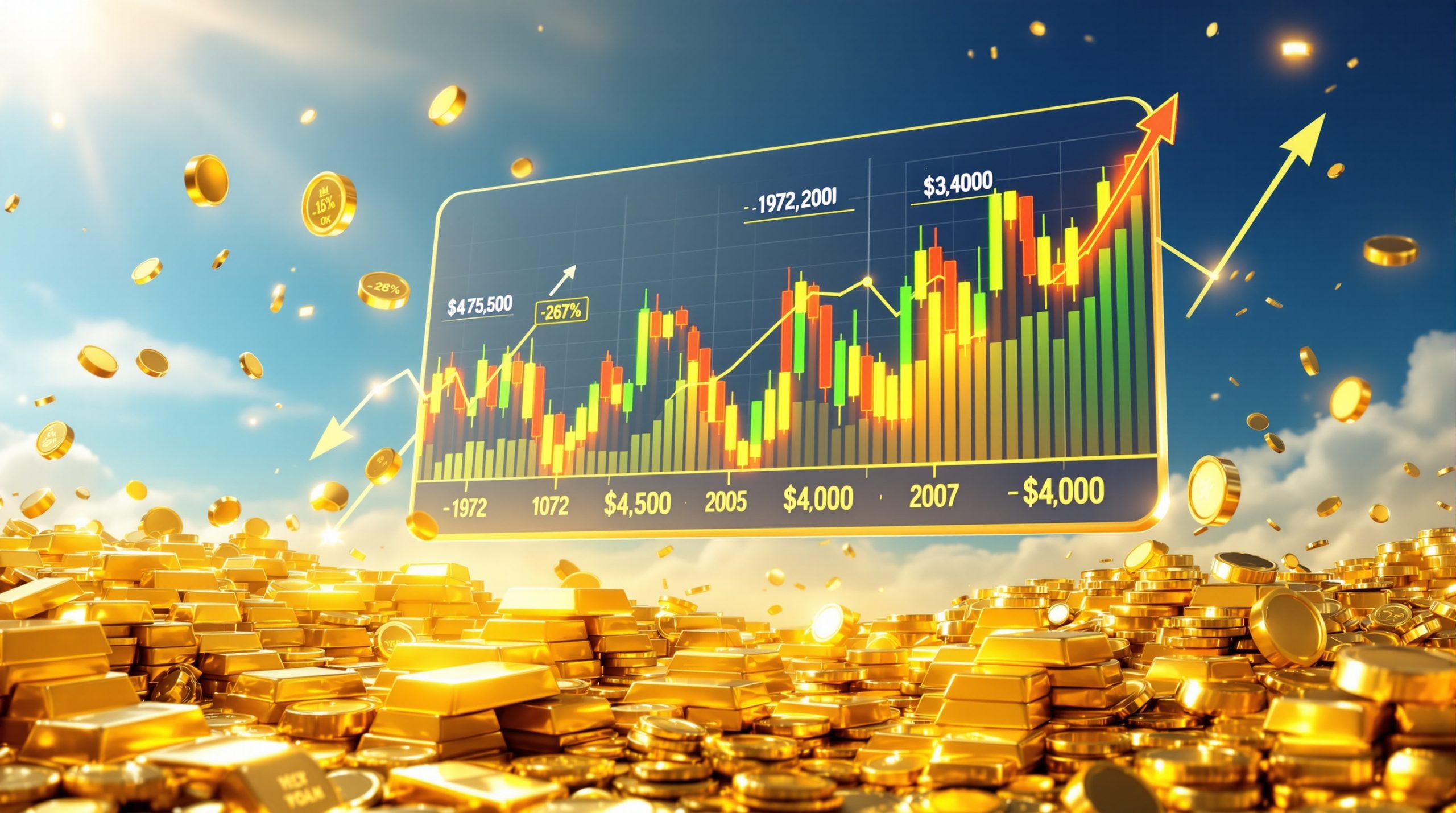What's Driving Gold to New All-Time Highs?
The gold market has been on an unprecedented tear, with spot prices soaring beyond $3,050 per ounce in 2024. This remarkable rally hasn't emerged from a vacuum but results from powerful structural shifts in the global financial landscape. At the forefront of this movement is aggressive central bank purchasing, creating what market analysts describe as a solid floor for gold prices.
"We're witnessing a paradigm shift in central bank behavior," notes Lobo Tiggre, CEO of Independent Speculator. "The weaponization of the dollar has pushed nations to diversify reserves away from U.S. assets, creating what appears to be a one-way door for gold accumulation."
This shift represents more than just a cyclical trend. Central banks, particularly from China, Russia, and various "Global South" nations, have systematically reduced their dollar dependence, adding substantial physical gold to their reserves. What makes this rally particularly notable is how gold has broken traditional correlation patterns – often rising simultaneously with the U.S. dollar, a historically unusual phenomenon indicating fundamental changes in market dynamics.
From a technical perspective, gold's breakthrough to all-time highs removes historical resistance levels. While the nominal price exceeds $3,050, the real inflation-adjusted all-time high would be just over $3,500 when accounting for purchasing power, suggesting potential for additional upside movement despite the already impressive gains seen in gold price trends and 2024 market analysis.
How Has Central Bank Buying Changed the Gold Market?
Central bank gold purchasing has fundamentally transformed market dynamics, becoming a dominant and persistent force unlike any period in modern financial history. In 2023 alone, central banks acquired over 1,040 metric tons of gold, the second-highest annual total on record, according to World Gold Council data.
"What makes this buying pattern significant isn't just the volume but the motivation behind it," explains Tiggre. "Nations are seeking monetary sovereignty in response to the perceived weaponization of the U.S. dollar through sanctions and financial restrictions."
This behavior represents a strategic, long-term pivot rather than tactical trading. Even when market conditions would typically create headwinds for gold – such as rising interest rates or a strengthening dollar – prices have remained resilient due to this sustained institutional demand. China and Russia have been particularly aggressive buyers, but smaller nations from Southeast Asia, the Middle East, and Eastern Europe have joined this diversification trend.
The resulting market dynamic creates a scenario where central banks effectively provide a price floor during corrections, absorbing physical metal that might otherwise pressure prices downward. This structural change has altered traditional gold market analysis, as institutional buying now frequently outweighs speculative trading flows.
Is a Gold Market Correction Imminent?
With gold prices exceeding $3,050 per ounce and having already met many analysts' price targets, investors naturally question whether a correction is on the horizon. Markets rarely move in straight lines, and profit-taking after such an extended rally would be consistent with historical patterns.
However, several factors complicate the correction thesis. First, gold breaking through all-time highs removes previous technical resistance levels, eliminating overhead supply that would typically cap rallies. Second, central bank buying provides persistent demand during pullbacks, potentially limiting the depth of corrections.
"When we evaluate probability distributions for gold prices, the higher probability currently favors continued upside movement despite extended technical indicators," notes Tiggre. "The absence of a price ceiling at new all-time highs creates a vacuum effect that can pull prices higher than fundamentals might otherwise justify."
Context matters when evaluating gold's absolute price. While $3,050 represents the nominal all-time high, the inflation-adjusted peak from 1980 would exceed $3,500 in today's dollars. Additionally, the approximately $15 trillion worth of physical gold globally remains small compared to other asset classes, making it susceptible to substantial price movements when investment flows shift.
Technical analysts point to elevated RSI (Relative Strength Index) readings and extreme positioning in futures markets as potential warning signs for a short-term correction. However, similar indicators have remained in overbought territory for extended periods during previous strong bull markets, as highlighted in analyses of gold's exceptional rise in 2024.
How Are Tariffs Impacting Precious Metals Markets?
Recent tariff policies have created significant tailwinds for precious metals markets through multiple channels. The direct impact comes through inflationary pressures, as tariffs essentially function as taxes on imported goods, raising consumer prices and production costs throughout supply chains.
"Even when tariff increases eventually stabilize, prices generally don't return to previous levels," explains Tiggre. "This creates a persistent inflationary environment that historically benefits monetary metals like gold and silver."
Beyond direct inflation effects, tariffs have amplified geopolitical tensions and trade uncertainty. Markets despise uncertainty, and the unpredictable nature of trade policy has driven risk-averse investors toward safe-haven assets. While central bank buying represents the dominant structural force in gold markets, tariff-induced inflation serves as an additional catalyst supporting the broader uptrend in gold and silver markets hitting all-time highs.
The Peterson Institute for International Economics estimates that recent U.S. tariff increases on Chinese goods have contributed between 1.5-2% to domestic inflation rates – a significant factor when evaluating gold's performance as an inflation hedge. Industrial metals within the precious metals complex, particularly silver and platinum group metals, face more complex impacts from tariffs, as industrial demand may decline while monetary demand increases.
For investors, distinguishing between structural and cyclical forces remains crucial. Tariffs represent a real but potentially temporary market driver, while central bank diversification appears to be a longer-term paradigm shift that will likely persist regardless of Trump's policies reshaping global commodity markets.
Why Should Investors Consider Silver Alongside Gold?
Silver occupies a unique position in the precious metals ecosystem, functioning simultaneously as both a monetary and industrial metal. This dual nature creates distinct investment characteristics compared to gold's primarily monetary role and copper's industrial focus.
"If you're bullish on both gold and copper, silver becomes a logical investment consideration," notes Tiggre. "It captures upside from both safe-haven monetary demand and industrial usage growth, particularly in green energy applications."
Despite occasional market skepticism (what Tiggre jokingly refers to as "Darth Silver" sentiment), silver maintains substantial monetary characteristics. Throughout history, silver has served as money for everyday transactions while gold functioned as larger-scale wealth storage – a relationship that explains silver's typically higher volatility and leverage to gold price movements.
Silver's industrial applications continue expanding, with solar panel production alone consuming over 140 million ounces annually. This industrial demand creates a floor under prices during economic expansion while monetary demand provides upside during financial uncertainty. The gold-to-silver ratio, historically averaging around 60:1 but reaching 80:1 or higher during crises, offers a metric for relative valuation between the metals.
For portfolio construction, silver's higher volatility creates both opportunities and risks compared to gold. Investors seeking maximum stability might favor gold, while those comfortable with greater fluctuations could benefit from silver's typically larger percentage moves during bull markets.
What Major Market Risks Should Investors Watch For?
Despite precious metals' strong performance, investors must remain vigilant about potential market risks that could disrupt even safe-haven assets. Among the most significant concerns is the possibility of deliberately "front-loaded" economic pain under the Trump administration's policy agenda.
"Economic reform often requires short-term disruption for long-term benefits," explains Tiggre. "Major deregulation initiatives could create temporary chaos across multiple sectors despite potentially positive long-term effects."
The Department of Government Efficiency (DOGE) could trigger significant institutional disruption through rapid personnel changes and regulatory revisions. While reducing bureaucratic overhead might benefit economic growth eventually, the transition period could generate substantial market volatility affecting all asset classes.
Recession risks remain elevated, with the Federal Reserve's probability models indicating a 35-40% chance of economic contraction in 2025. During severe liquidity crises, even gold can face selling pressure as investors liquidate positions to meet margin calls or raise cash. The 2008 financial crisis demonstrated this dynamic, with gold initially declining alongside other assets before rebounding dramatically as monetary policy responses kicked in.
Energy and industrial metals would likely face more significant downside in a recession scenario than monetary metals. However, investors should maintain cash reserves to capitalize on potential buying opportunities during market stress rather than being fully invested even in precious metals. Some analysts have already issued bold gold price forecasts for 2025 based on these market conditions.
How Would a Liquidity Crisis Affect Precious Metals?
During severe market dislocations, even gold and silver can experience temporary selling pressure despite their safe-haven reputation. The mechanics behind this counterintuitive behavior stem from margin calls forcing investors to sell their most liquid assets to meet obligations.
"When margin clerks come calling, investors sell what they can, not what they want to," notes Tiggre. "Gold and silver's high liquidity makes them vulnerable to forced selling during systemic crises, creating temporary price declines before their fundamental monetary value reasserts itself."
The March 2020 COVID market panic exemplifies this dynamic, with gold dropping nearly 15% alongside equities before staging a powerful recovery. Industrial metals typically face more sustained pressure during liquidity crises, as economic contractions directly impact demand fundamentals. Copper, often called "Dr. Copper" for its ability to diagnose economic health, generally underperforms monetary metals during recessions.
Energy minerals, including uranium, similarly face downward pressure during liquidity events, though their unique supply-demand fundamentals can sometimes create divergent price behavior. The key differentiator between metals during crises becomes their recovery pattern – monetary metals typically rebound faster as stimulus efforts increase inflation expectations and currency debasement concerns.
For investors, maintaining substantial cash positions during periods of elevated financial stress creates valuable optionality. This liquidity allows for strategic acquisitions of quality resource assets at distressed prices when margin-driven selling creates temporary disconnects from fundamental valuations.
How Can Investors Evaluate Resource Companies?
Navigating the complex landscape of resource companies requires specialized analytical frameworks beyond typical equity evaluation methods. Independent analysis becomes crucial given the sector's technical complexity and potential conflicts of interest in research coverage.
"Comprehensive databases covering nearly 1,000 resource companies provide essential filtering capabilities by metal type, geography, and development stage," explains Tiggre. "This allows investors to identify opportunities matching their specific risk tolerance and market thesis."
The most valuable analytical resources maintain independence from company payments to ensure unbiased evaluations. When research providers accept funding from the companies they cover, conflicts inevitably arise that can compromise recommendation quality. Second opinions become particularly valuable both when building positions and when deciding which holdings to prune during portfolio optimization.
Effective resource company analysis requires evaluating geological potential, management quality, jurisdiction risk, and project economics simultaneously. Single-factor approaches frequently lead to investment mistakes, as a company with excellent geology but poor management or unmanageable political risk rarely delivers satisfactory returns regardless of commodity price movements.
For retail investors without mining industry expertise, focusing on producers with proven cash flow rather than exploration companies can reduce risk while still providing substantial leverage to rising metal prices. Those seeking higher-risk/reward profiles should consider allocating smaller portions of their portfolio to well-managed explorers and developers while maintaining core positions in established producers. Understanding why gold stocks underperform can also be crucial for maximizing returns in this sector.
FAQ: Gold and Silver Investment Questions
What is the current all-time high price for gold?
Gold has exceeded $3,050 per ounce (spot price), representing both nominal and inflation-adjusted all-time highs. When accounting for inflation, the previous 1980 high would equate to approximately $3,500 in today's dollars, according to Trading Economics data.
Is central bank buying of gold likely to continue?
Yes, central bank gold purchasing represents a fundamental paradigm shift rather than a cyclical trend. The "weaponization of the dollar" through sanctions has pushed nations to diversify reserves away from U.S. assets, creating structural demand likely to persist regardless of short-term price fluctuations.
How do tariffs affect precious metals prices?
Tariffs generally benefit precious metals through multiple channels: they create inflationary pressures favoring gold and silver as inflation hedges; they increase economic uncertainty driving safe-haven demand; and they heighten geopolitical tensions supporting risk-off investment positioning.
Should investors be concerned about a market correction?
While technical indicators suggest the possibility of a correction after such a strong rally, gold breaking through all-time highs removes previous resistance levels. Central bank buying provides substantial support during pullbacks, potentially limiting correction depth compared to previous cycles.
How does silver compare to gold as an investment?
Silver offers dual exposure to both monetary and industrial demand drivers, typically demonstrating higher volatility than gold. During precious metals bull markets, silver often outperforms gold on a percentage basis, while underperforming during bear markets due to its smaller market size and industrial demand component.
Want to Know When the Next Big Gold Discovery Hits the Market?
Discovery Alert's proprietary Discovery IQ model delivers instant notifications of significant ASX mineral discoveries, turning complex gold market data into actionable investment opportunities. Explore our dedicated discoveries page to see how historic gold discoveries have generated exceptional returns and begin your 30-day free trial today.




